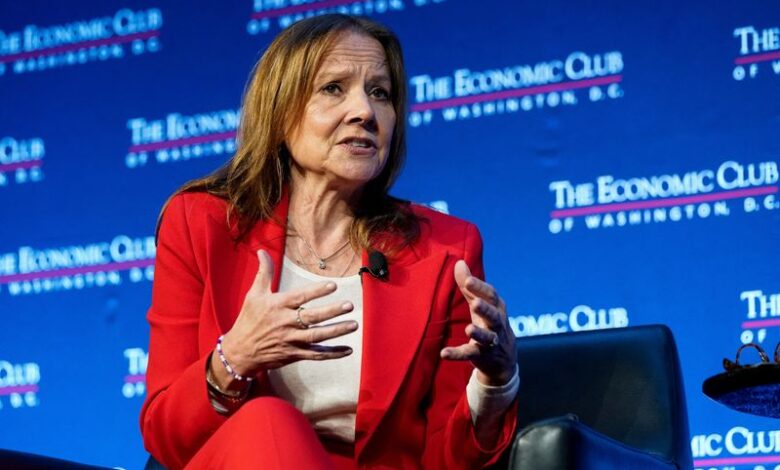GM and Ford count on gas-powered trucks as EV growth slows

By Joseph White
DETROIT (Reuters) – U.S. automakers General Motors and Ford face a challenge in common when they report first-quarter results next week: Explaining to investors where profit growth will come from in the months ahead as EV growth slows.
The slowdown in global electric-vehicle demand, intensifying competition from Chinese automakers and high U.S. borrowing costs have forced the U.S. automakers to delay investments and ratchet down costs over the past 12 months. With China’s economy slowing and U.S. inflation running hot, a macroeconomic growth boost looks a long way off.
That has companies like GM and Ford focusing on sales of their core gasoline-powered vehicles, from which they derive most of their profit. GM and Ford are scheduled to report results on Tuesday and Wednesday, respectively.
GM CEO Mary Barra will get a lift from strong demand for the automaker’s highly profitable Chevrolet and GMC brand pickup trucks and SUVs. Barclays earlier this month boosted its target price for GM shares by 10% to $55, citing robust sales for GM’s truck and SUV lineup.
GM Chief Financial Officer Paul Jacobson said the year was off to a good start and the company felt positive about where demand was trending, while Ford CFO John Lawler, in reaffirming the company’s full-year profit outlook, said vehicle prices were holding up better than expected.
Legacy U.S. automakers, which rely heavily on sales of large trucks and SUVs, have been bogged down by higher expenses related to electrifying their vehicle lineups and bumpy demand for battery-electric vehicles.
Evercore ISI analyst Chris McNally said in a research note that the momentum has shifted for the previous winners like Tesla as growth in EV sales slows. Investors have refocused instead on GM, Stellantis, Toyota and others that rely less on EVs, he added.
The high ratio of gas-burning trucks to EVs in GM’s North American sales mix will help offset a projected loss in the automaker’s operations in China. GM said first-quarter U.S. vehicle sales slipped 1.5% on lower commercial-customer deliveries, but retail sales jumped 6%.
Barra has yet to outline specific plans for restructuring GM’s China business. Last year, GM delivered 2.1 million vehicles in China, down almost half from the 4.04 million it reported in 2017.
Meanwhile, investors want an update at GM’s struggling Cruise robotaxi unit.
Barra has not said how GM will fund relaunching and rebuilding the business after a serious accident forced the company to halt driverless ride operations. GM has said it will slash spending by $1 billion this year at Cruise. The unit has lost more than $8 billion since GM acquired it in 2016.
Cruise said on April 9 it will put some vehicles back on the road in Phoenix, Arizona, with human drivers.
The Detroit automaker’s shares jumped in January when it signaled more cash would be returned to shareholders.
Ford, too, is getting power from its combustion truck business, as well as its Ford Pro commercial vehicle operations. The automaker reaffirmed its forecast for $10 billion to $12 billion in core profit this year.
The automaker earlier this month said it would slow two major electric-vehicle programs. CFO Lawler told an investor conference that future EV investments will not go forward unless they can “stand on their own” to show a profit.
(Reporting by Joe White in Detroit; Additional reporting by Ben Klayman in Detroit; Editing by Matthew Lewis)



